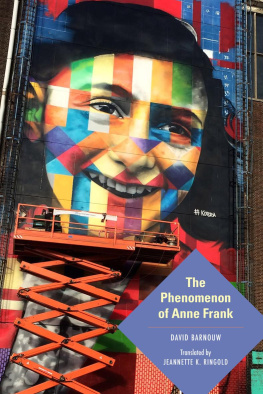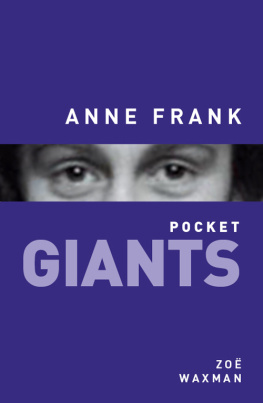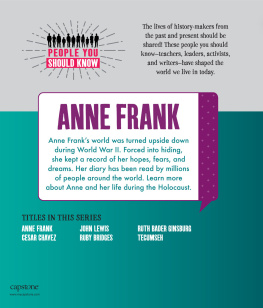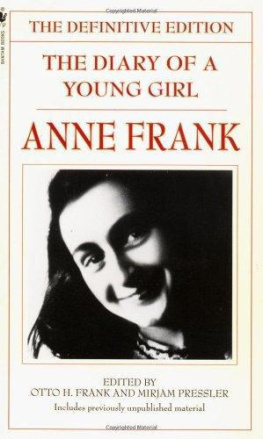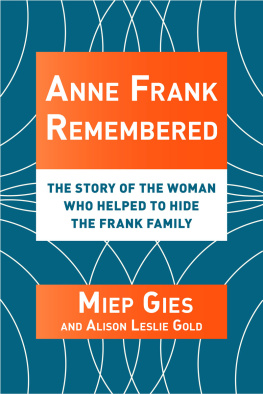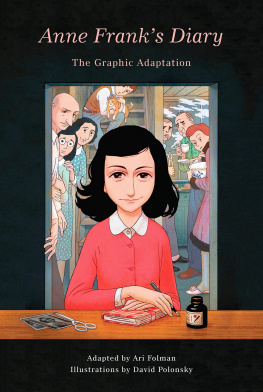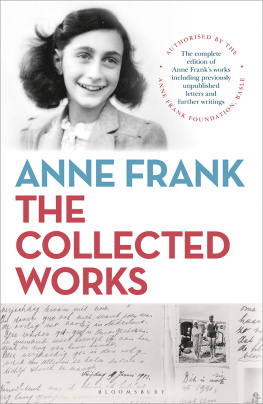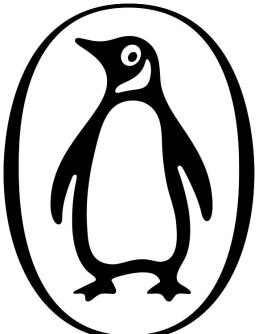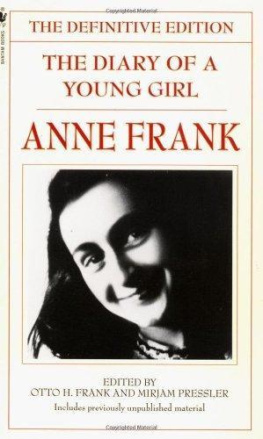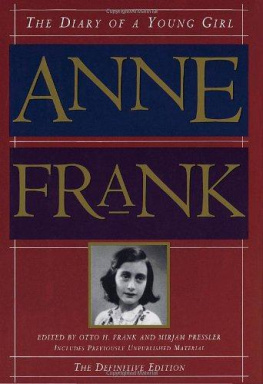The
Phenomenon
of Anne Frank
JEWISH LITERATURE AND CULTURE
Alvin H. Rosenfeld, editor
The
Phenomenon
of Anne Frank
DAVID BARNOUW
Translated by
JEANNETTE K. RINGOLD
Indiana University Press
This book is a publication of
Indiana University Press
Office of Scholarly Publishing
Herman B Wells Library 350
1320 East 10th Street
Bloomington, Indiana 47405 USA
iupress.indiana.edu
Originally published as: David Barnouw, Het Fenomeen Anne Frank
(Amsterdam, Bert Bakker 2012)
2012 by David Barnouw
English translation 2018 by Indiana University Press
Cover KOBRA, photo by Elma Verhey
Indiana University Press gratefully acknowledges the support of the Dutch Foundation for Literature
All rights reserved
No part of this book may be reproduced or utilized in any form or by any means, electronic or mechanical, including photocopying and recording, or by any information storage and retrieval system, without permission in writing from the publisher. The Association of American University Presses Resolution on Permissions constitutes the only exception to this prohibition.
The paper used in this publication meets the minimum requirements of the American National Standard for Information SciencesPermanence of Paper for Printed Library Materials, ANSI Z39.481992.
Manufactured in the United States of America
Cataloging information is available from the Library of Congress.
ISBN 978-0-253-02966-9 (cloth)
ISBN 978-0-253-03118-1 (paperback)
ISBN 978-0-253-03119-8 (ebook)
1 2 3 4 5 23 22 21 20 19 18
Contents
Authors Note
IN ORDER TO MAKE THIS book more readable, no footnotes have been used, but where necessary, the text refers to the sources.
The two books that precede this one, De Dagboeken van Anne Frank (1986) [the Dutch critical edition of the diary] and Anne Frank voor beginners and gevorderden (1998) [Anne Frank for beginners and for advanced students] cite a lot of source material. The first book deals primarily with archival material, whereas the second book is based primarily on publications on the subject.
In addition to these two books with source material, there is an extensive collection of Anne Frank clippings consisting of seven archival boxes at the NIOD (Institute for War, Holocaust, and Genocide Studies), and an increasing amount of material is now becoming available on the internet.
Het Anne Frank Huis. Een biografie by Jos van der Lans and Herman Vuijsje, published in 2010, also contains a wealth of material.
is based partly on Barnouw/Van der Stroom/Paape, De Dagboeken van Anne Frank (Amsterdam, 1986) and Barnouw/Van der Stroom, Wie verraadde Anne Frank? Den Haag, 2003).
is based partly on Barnouw/Van der Stroom/Paape, De Dagboeken van Anne Frank (Amsterdam, 1986) and Schroth, Das Tagebuch etc. (2006).
is based partly on Barnouw/Van der Stroom/Paape, De Dagboeken van Anne Frank (Amsterdam, 1986), Graver, An Obsession with etc. (1995), and Melnick, The Stolen Legacy etc. (1995).
is based partly on Barnouw, Een delicaat onderwerp etc. (1995).
is based partly on De Dagboeken van Anne Frank (1986) and later newspaper clippings.
is based partly on Barnouw, Anne Frank voor beginners and gevorderden (1998).
is based partly on a symposium that was organized in 2007 by the NIOD and the Anne Frank House on the occasion of the seventieth anniversary of Het Achterhuis.
Translators Note
I HAVE FOLLOWED THE AUTHORS lead. When the author says that he has not used footnotes and has based various chapters partly on previous publications, I have done the same. The principal source for much of this book was the critical edition of the diary. Instead of the Dutch critical edition, De Dagboeken van Anne Frank, I have used the English version published in 2003, The Diary of Anne Frank: The Revised Critical Edition.
De Dagboeken van Anne Frankto avoid confusion with various translations, I have not translated this title when it refers to the Dutch publication. When the critical edition of the diary is used, it refers to either the Dutch or the English version.
Het Achterhuisthe title of the original 1947 publication of Annes diary. To avoid confusion with various translations, I have not translated this title when it refers to the Dutch publication.
When quoting from Anne Franks diary, I have used The Diary of a Young Girl: The Definitive Edition. New York: Doubleday, 1995, which was edited by Otto Frank and Miriam Pressler and translated by Susan Massotty.
The Anne Frank Stichting in Amsterdam, a foundation that was established in 1957 and manages the museum at 263 Prinsengracht is called the Anne Frank House.
The Anne Frank Fonds in Basel is called the Anne Frank Foundation, or the Foundation.
NIOD is the Netherlands Institute for War, Holocaust, and Genocide Studies (formerly RIODNetherlands State Institute for War Documentation).
Introduction
ON SUNDAY, APRIL 27, 2014, amid great public interest, a cutting from the famous Anne Frank tree was planted in the garden of the Capitol in Washington, DC. Many seedlings of this chestnut tree had been cultivated after it blew down in the summer of 2010. The United States received eleven in addition to the one next to the Capitol. Cuttings were planted on the Boston Common, in Liberty Park in New York City, and in the Clinton Presidential Center in Little Rock to mention a few. The main theme at these tree-plantings was Annes indomitable spirit enduring through her book and plantings although her life was cut tragically short.
A week later, on May 8, 2014, I was present at the world premiere of the new play, ANNE, in a theater especially built for it in Amsterdam. The Dutch king, the minister of education, the mayor of Amsterdam, and other dignitaries were all present. It was a significant evening that had been anticipated for a long time, but it was also surrounded by discussions about whether going to see Anne could be considered a nice evening out. The most important discussions revolved around the question to whom Anne actually belonged and who should speak for her.
This was clear until the death of Annes father, Otto Frank, in 1980; on being asked, he explained what Anne had meant. Subsequently, it was the Anne Frank House in Amsterdam, the administrator of the Annex on Prinsengracht, which guarded her legacy.
With a new play, an organization that had remained in the shadows came forward, claiming to administer Anne Franks legacy. This organization is the Anne Frank Foundation in Basel, which was established by Otto Frank in 1963. The Foundation administered the money from the royalties of the diary and passed it on to good causes. How much money has come in and has been given away during the more than fifty years of the existence of the Foundation is unknown.
Several times during the past decades, the Anne Frank Foundation backed a film production about Anne Frank while the Anne Frank House was against it, or vice versa. The Foundation occasionally instituted legal proceedings against the Anne Frank House when tensions between the two organizations mounted. The Anne Frank Foundation gave very little money for the extensive renovation of the Annex on Prinsengracht made at the end of the twentieth century. The outside world noticed little of the internal bickering, and it seemed as though the Anne Frank Foundation and the Anne Frank House were jointly protecting Annes legacy against wrongdoers.

